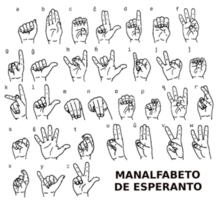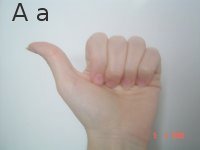
An Esperanto manual alphabet is included as part of the Signuno project for manually coded Esperanto. Signuno is based on the signs of International Sign, but adapted to the grammatical system of Esperanto.

An Esperanto manual alphabet is included as part of the Signuno project for manually coded Esperanto. Signuno is based on the signs of International Sign, but adapted to the grammatical system of Esperanto.
The letters are all to be signed upright with a straight wrist, and palm outward, so for example the G resembles D, as in the French manual alphabet, although the D fingers are more open (like O) and the index finger is shorter. None of the letters involve motion (again like the static wrist this is to allow greater accessibility for certain disabled groups), so J and Z are distinct from other alphabets: J is like a Cyrillic J; and Z has the form of an ASL 3 (which appears to be unique to Signuno, and may have its origins in Cyrillic letter З (z) being similar in shape to the number 3).
Other differences from the American manual alphabet are: [1]
The diacritic letters Ĉ, Ĝ, Ĥ, Ĵ, Ŝ, Ŭ are sometimes derived from their base letters:
Unlike in Gestuno, Signuno digits are all made on a single hand. For 1 to 4, the fingers are extended from the index to the pinkie. Thus Signuno '3' looks like an ASL '6'. 5 is the international (and ASL) '5' hand. For 6 to 9, the fingers are extended from the pinkie to the thumb, skipping the middle finger so that 8 is the ASL '8'. Apart from facing inwards or (in the case of 0 and 10) to the side rather than outward as the letters do, they thus have the shapes of the Signuno letters O (0), G (1), V (2), W (3), [ASL 4] (4), Ŝ [ASL 5] (5), I (6), J (7), Q [ASL 8] (8), [ASL handshape for 'feel'] (9).
Powers of ten have the palm pointing to the side. 10 is signed as the Roman numeral X. As in ASL, 100 and 1000 are signed as the Roman numerals C and M.
For hours and months, there are additional sign for 11 and 12, which have the shapes of the letters Ĝ (11) and L (12) but turned so the palm faces the signer.
When working in hexadecimal, the pattern can be extended to 13 and 14 (i.e., 13 in hex is a turned Z hand), while 15 (hexadecimal 'F') is a turned F hand. [2]
Images and precise definitions for the letters and number can be found in the Signuno documentation. [3]

D, or d, is the fourth letter of the Latin alphabet, used in the modern English alphabet, the alphabets of other western European languages and others worldwide. Its name in English is dee, plural dees.

Fingerspelling is the representation of the letters of a writing system, and sometimes numeral systems, using only the hands. These manual alphabets have often been used in deaf education and have subsequently been adopted as a distinct part of a number of sign languages. There are about forty manual alphabets around the world. Historically, manual alphabets have had a number of additional applications—including use as ciphers, as mnemonics and in silent religious settings.

Sign languages are languages that use the visual-manual modality to convey meaning, instead of spoken words. Sign languages are expressed through manual articulation in combination with non-manual markers. Sign languages are full-fledged natural languages with their own grammar and lexicon. Sign languages are not universal and are usually not mutually intelligible, although there are also similarities among different sign languages.
Sutton SignWriting, or simply SignWriting, is a system of writing sign languages. It is highly featural and visually iconic, both in the shapes of the characters, which are abstract pictures of the hands, face, and body, and in their spatial arrangement on the page, which does not follow a sequential order like the letters that make up written English words. It was developed in 1974 by Valerie Sutton, a dancer who had, two years earlier, developed DanceWriting. Some newer standardized forms are known as the International Sign Writing Alphabet (ISWA).
Esperanto is written in a Latin-script alphabet of twenty-eight letters, with upper and lower case. This is supplemented by punctuation marks and by various logograms, such as the digits 0–9, currency signs such as $ € ¥ £ ₷, and mathematical symbols. The creator of Esperanto, L. L. Zamenhof, declared a principle of "one letter, one sound", though this is a general rather than strict guideline.
The American Manual Alphabet (AMA) is a manual alphabet that augments the vocabulary of American Sign Language.
Several manual alphabets in use around the world employ two hands to represent some or all of the letters of an alphabet, usually as a part of a deaf sign language. Two-handed alphabets are less widespread than one-handed manual alphabets. They may be used to represent the Latin alphabet or the Cyrillic alphabet.

The OK gesture or OK sign or ring gesture is performed by joining the thumb and index finger in a circle, and holding the other fingers straight or relaxed away from the palm. Commonly used by scuba divers, it signifies "I am OK" or "Are you OK?" when underwater. In most English-speaking countries it denotes approval, agreement, and that all is well or "okay". In other contexts or cultures, similar gestures may have different meanings including those that are negative, offensive, financial, numerical, devotional, political, or purely linguistic.
The Japanese Sign Language syllabary is a system of manual kana used as part of Japanese Sign Language (JSL). It is a signary of 45 signs and 4 diacritics representing the phonetic syllables of the Japanese language. Signs are distinguished both in the direction they point, and in whether the palm faces the viewer or the signer. For example, the manual syllables na, ni, ha are all made with the first two fingers of the hand extended straight, but for na the fingers point down, for ni across the body, and for ha toward the viewer. The signs for te and ho are both an open flat hand, but in te the palm faces the viewer, and in ho it faces away.

Stokoe notation is the first phonemic script used for sign languages. It was created by William Stokoe for American Sign Language (ASL), with Latin letters and numerals used for the shapes they have in fingerspelling, and iconic glyphs to transcribe the position, movement, and orientation of the hands. It was first published as the organizing principle of Sign Language Structure: An Outline of the Visual Communication Systems of the American Deaf (1960), and later also used in A Dictionary of American Sign Language on Linguistic Principles, by Stokoe, Casterline, and Croneberg (1965). In the 1965 dictionary, signs are themselves arranged alphabetically, according to their Stokoe transcription, rather than being ordered by their English glosses as in other sign-language dictionaries. This made it the only ASL dictionary where the reader could look up a sign without first knowing how to translate it into English. The Stokoe notation was later adapted to British Sign Language (BSL) in Kyle et al. (1985) and to Australian Aboriginal sign languages in Kendon (1988). In each case the researchers modified the alphabet to accommodate phonemes not found in ASL.
Israeli Sign Language, also known as Shassi or ISL, is the most commonly used sign language by the Deaf community of Israel. Some other sign languages are also used in Israel, among them Al-Sayyid Bedouin Sign Language.
American Sign Language (ASL), the sign language used by the deaf community throughout most of North America, has a rich vocabulary of terms, which include profanity. Within deaf culture, there is a distinction drawn between signs used to curse versus signs that are used to describe sexual acts. In usage, signs to describe detailed sexual behavior are highly taboo due to their graphic nature. As for the signs themselves, some signs do overlap, but they may also vary according to usage. For example, the sign for "shit" when used to curse is different from the sign for "shit" when used to describe the bodily function or the fecal matter.
In sign languages, handshape, or dez, refers to the distinctive configurations that the hands take as they are used to form words. In Stokoe terminology it is known as the DEZ, an abbreviation of designator. Handshape is one of five components of a sign, along with location, orientation, movement, and nonmanual features. Different sign languages make use of different handshapes.
The grammar of American Sign Language (ASL) has rules just like any other sign language or spoken language. ASL grammar studies date back to William Stokoe in the 1960s. This sign language consists of parameters that determine many other grammar rules. Typical word structure in ASL conforms to the SVO/OSV and topic-comment form, supplemented by a noun-adjective order and time-sequenced ordering of clauses. ASL has large CP and DP syntax systems, and also doesn't contain many conjunctions like some other languages do.

The French manual alphabet is an alphabet used for French Sign Language (LSF), both to distinguish LSF words and to sign French words in LSF.
The Hamburg Sign Language Notation System, or HamNoSys, is a transcription system for all sign languages, with a direct correspondence between symbols and gesture aspects, such as hand location, shape and movement. It was developed in 1985 at the University of Hamburg, Germany. As of 2020, it is in its fourth revision.
In sign language, an initialized sign is one that is produced with a handshape(s) that corresponds to the fingerspelling of its equivalent in the locally dominant oral language, based on the respective manual alphabet representing that oral language's orthography. The handshape(s) of these signs then represent the initial letter of their written equivalent(s). In some cases, this is due to the local oral language having more than one equivalent to a basic sign. For example, in ASL, the signs for "class" and "family" are the same, except that "class" is signed with a 'C' handshape, and "family" with an 'F' handshape. In other cases initialization is required for disambiguation, though the signs are not semantically related. For example, in ASL, "water" it signed with a 'W' handshape touching the mouth, while "dentist" is similar apart from using a 'D' handshape. In other cases initialization is not used for disambiguation; the ASL sign for "elevator", for example, is an 'E' handshape moving up and down along the upright index finger of the other hand.
Sign languages such as American Sign Language (ASL) are characterized by phonological processes analogous to, yet dissimilar from, those of oral languages. Although there is a qualitative difference from oral languages in that sign-language phonemes are not based on sound, and are spatial in addition to being temporal, they fulfill the same role as phonemes in oral languages.

ASLwrite is a writing system that developed from si5s. It was created to be an open-source, continuously developing orthography for American Sign Language (ASL), trying to capture the nuances of ASL's features. ASLwrite is only used by a handful of people, primarily revolving around discussions happening on Facebook and, previously, Google Groups. ASLwrite has been used for comic strips and posters.